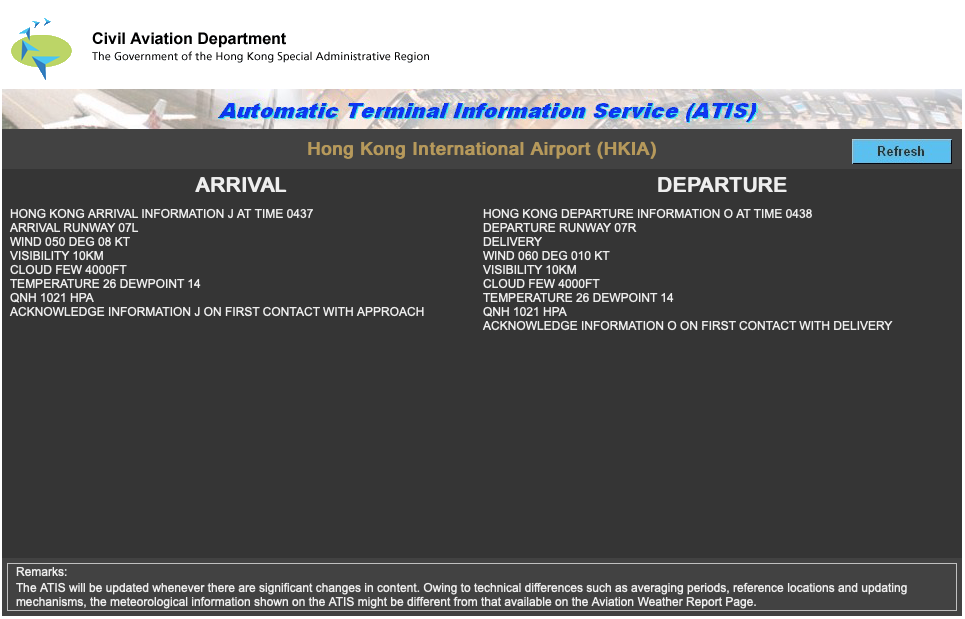Automatic terminal information service, or ATIS, is a continuous broadcast of recorded aeronautical information in busier terminal areas, i.e. airports and their immediate surroundings. ATIS broadcasts contain essential information, such as current weather information, active runways, available approaches, and any other information required by the pilots, such as important NOTAMs. Pilots usually listen to an available ATIS broadcast before contacting the local control unit, which reduces the controllers' workload and relieves frequency congestion.
The recording is updated in fixed intervals or when there is a significant change in the information, e.g. a change in the active runway. It is given a letter designation (e.g. bravo) from the ICAO spelling alphabet. The letter progresses through the alphabet with every update and starts at alpha after a break in service of 12 hours or more. When contacting the local control unit, pilots indicate their information <letter>, where <letter> is the ATIS identification letter of the ATIS transmission the pilot received.
The pilot listens to the ATIS just prior initial contact and notes the code letter; on check-in, the pilot reports the code letter of the ATIS copied. This enables the controller to confirm that the pilot has copied the current ATIS. Normal practice is for the controller to up-date the pilot if the ATIS or any element of it subsequently changes materially.
Many airports also employ the use of Data-link ATIS (D-ATIS). D-ATIS is a text-based, digitally transmitted version of the ATIS audio broadcast. It is accessed via a datalink service such as the ACARS and displayed on an electronic display in the aircraft. D-ATIS is incorporated on the aircraft as part of its electronic system, such as an EFB or an FMS. D-ATIS may be incorporated into the core ATIS system, or be realized as a separate system with a data interface between voice ATIS and D-ATIS.

Content of Voice-ATIS Broadcasts
Voice-ATIS broadcasts normally contain the following information in the order listed:
- name of aerodrome;
- arrival and/or departure indicator;
- contract type, if communication is via D-ATIS;
- designator;
- time of observation, if appropriate;
- type of approach(es) to be expected;
- the runway(s) in use; status of arresting system constituting a potential hazard, if any;
- significant runway surface conditions and, if appropriate, braking action;
- holding delay, if appropriate;
- transition level, if applicable;
- other essential operational information;
- surface wind direction (in degrees magnetic) and speed, including significant variations and, if surface wind sensors related specifically to the sections of runway(s) in use are available and the information is required by operators, the indication of the runway and the section of the runway to which the information refers;
- visibility and, when applicable, RVR;
- present weather;
- cloud below 1 500 m (5 000 ft) or below the highest minimum sector altitude, whichever is greater; cumulonimbus; if the sky is obscured, vertical visibility when available;
- air temperature;
- dew point temperature;
- altimeter setting(s);
- any available information on significant meteorological phenomena in the approach and climb-out areas including wind shear, and information on recent weather of operational significance;
- trend forecast, when available; and
- specific ATIS instructions.
Voice ATIS may be transmitted on a dedicated VHF communications frequency or as the voice element of a navigational facility (e.g. VOR).
At busy airports, separate ATIS broadcasts may be made for arrivals and for departures.
Example ATIS
HONG KONG DEPARTURE INFORMATION O AT TIME 0438
DEPARTURE RUNWAY 07R
DELIVERY
WIND 060 DEG 010 KT
VISIBILITY 10KM
CLOUD FEW 4000FT
TEMPERATURE 26 DEWPOINT 14
QNH 1021 HPA
ACKNOWLEDGE INFORMATION O ON FIRST CONTACT WITH DELIVERY
You can practice listening to ATIS below
{mp3}ATIS 1{/mp3}
{mp3}ATIS 3{/mp3}
{mp3}ATIS 5{/mp3}
and on Aviation English Radio, usually from a different aerodrome on the hour.
For more aviation vocabulary visit http://aviationenglish.com/learning-zone/aviation-vocabulary/



.jpg)